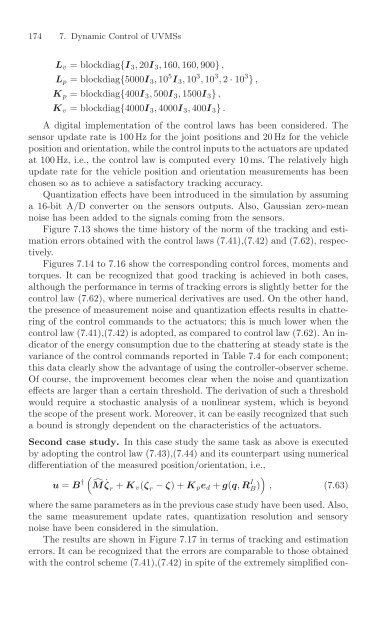Underwater Robots - Gianluca Antonelli.pdf
Underwater Robots - Gianluca Antonelli.pdf
Underwater Robots - Gianluca Antonelli.pdf
You also want an ePaper? Increase the reach of your titles
YUMPU automatically turns print PDFs into web optimized ePapers that Google loves.
174 7. Dynamic Control of UVMSs<br />
L v =blockdiag { I 3 , 20I 3 , 160, 160, 900} ,<br />
L p =blockdiag { 5000I 3 , 10 5 I 3 , 10 3 , 10 3 , 2 · 10 3 } ,<br />
K p =blockdiag { 400I 3 , 500I 3 , 1500I 3 } ,<br />
K v =blockdiag { 4000I 3 , 4000I 3 , 400I 3 } .<br />
Adigital implementation ofthe control laws has been considered. The<br />
sensor update rate is 100Hzfor the joint positions and 20 Hz for the vehicle<br />
position and orientation, while the control inputs to the actuators are updated<br />
at 100Hz, i.e., the control law iscomputed every 10 ms. The relatively high<br />
update rate for the vehicle position and orientation measurements has been<br />
chosen soastoachieve asatisfactory tracking accuracy.<br />
Quantization effects have been introduced in the simulation by assuming<br />
a16-bit A/D converter onthe sensors outputs. Also, Gaussian zero-mean<br />
noise has been added to the signals coming from the sensors.<br />
Figure 7.13 shows the time history of the norm ofthe tracking and estimation<br />
errors obtained with the control laws (7.41),(7.42) and (7.62), respectively.<br />
Figures 7.14 to7.16 show the corresponding control forces, moments and<br />
torques. It can be recognized that good tracking is achieved in both cases,<br />
although the performance in terms of tracking errors is slightly better for the<br />
control law (7.62), where numerical derivatives are used. Onthe other hand,<br />
the presence ofmeasurement noise and quantization effects results in chattering<br />
of the control commands to the actuators; this ismuch lower when the<br />
control law (7.41),(7.42) isadopted, as compared to control law (7.62). An indicator<br />
of the energy consumption due tothe chattering atsteady state is the<br />
variance of the control commands reported inTable 7.4 for each component;<br />
this data clearly show the advantage of using the controller-observer scheme.<br />
Of course, the improvement becomes clear when the noise and quantization<br />
effects are larger than acertain threshold. The derivation ofsuch athreshold<br />
would require astochastic analysis ofanonlinear system, which isbeyond<br />
the scope ofthe present work. Moreover, it can beeasily recognized that such<br />
abound is strongly dependent on the characteristics ofthe actuators.<br />
Second case study. In this case study the same task as above is executed<br />
by adopting the control law (7.43),(7.44) and its counterpart using numerical<br />
differentiation ofthe measured position/orientation, i.e.,<br />
u = B † � M � ζ ˙<br />
r + K v ( ζ r − ζ )+K p e d + g ( q , R I �<br />
B ) , (7.63)<br />
wherethe same parameters as in theprevious case study have been used.Also,<br />
the same measurement update rates, quantization resolution and sensory<br />
noise have been considered in the simulation.<br />
The results are shown in Figure 7.17 interms of tracking and estimation<br />
errors. It can be recognized that the errors are comparable to those obtained<br />
with the control scheme (7.41),(7.42) inspite ofthe extremely simplified con-






